Kuppan T. Heat Exchanger Design Handbook
Подождите немного. Документ загружается.

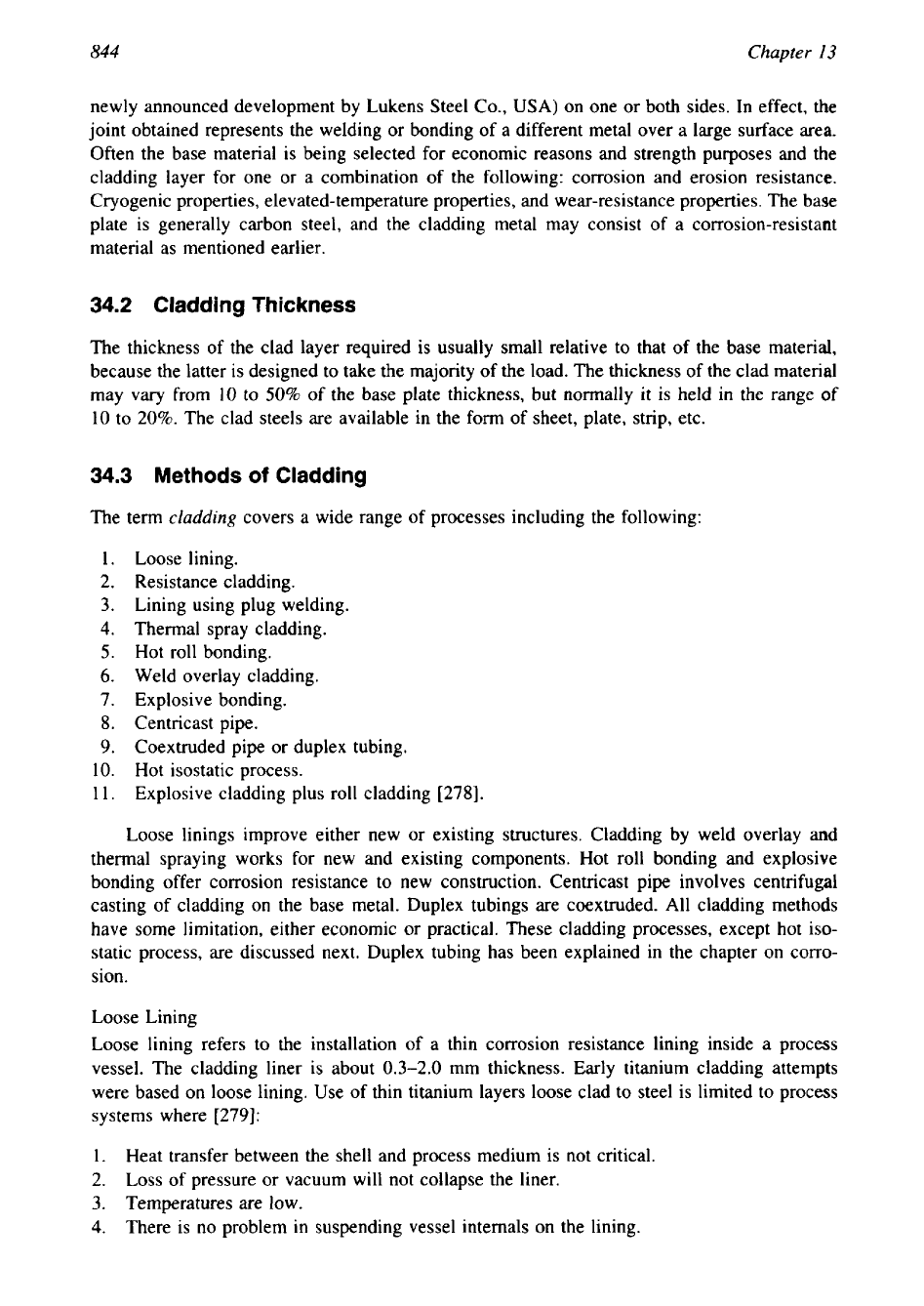
844
Chapter
I3
newly announced development by Lukens Steel Co., USA) on one or both sides. In effect, the
joint obtained represents the welding or bonding of a different metal over a large surface area.
Often the base material is being selected for economic reasons and strength purposes and the
cladding layer for one or a combination of the following: corrosion and erosion resistance.
Cryogenic properties, elevated-temperature properties, and wear-resistance properties. The base
plate is generally carbon steel, and the cladding metal may consist of a corrosion-resistant
material as mentioned earlier.
34.2
Cladding
Thickness
The thickness of the clad layer required is usually small relative to that of the base material,
because the latter is designed to take the majority of the load. The thickness of the clad material
may
vary
from
10
to
50%
of the base plate thickness, but normally it is held in the range of
10
to
20%.
The clad steels are available in the form of sheet, plate, strip, etc.
34.3
Methods
of
Cladding
The term
cladding
covers a wide range of processes including the following:
1.
Loose lining.
2.
Resistance cladding.
3.
Lining using plug welding.
4.
Thermal spray cladding.
5.
Hot roll bonding.
6.
Weld overlay cladding.
7.
Explosive bonding.
8.
Centricast pipe.
9.
Coextruded pipe or duplex tubing.
10.
Hot isostatic process.
11.
Explosive cladding plus roll cladding
[278].
Loose linings improve either new or existing structures. Cladding by weld overlay and
thermal spraying works for new and existing components. Hot roll bonding and explosive
bonding offer corrosion resistance to new construction. Centricast pipe involves centrifugal
casting of cladding on the base metal. Duplex tubings are coextruded. All cladding methods
have some limitation, either economic or practical. These cladding processes, except hot
iso-
static process, are discussed next. Duplex tubing has been explained in the chapter on corro-
sion.
Loose Lining
Loose lining refers to the installation of a thin corrosion resistance lining inside a process
vessel. The cladding liner is about
0.3-2.0
mm thickness. Early titanium cladding attempts
were based on loose lining. Use of thin titanium layers loose clad to steel is limited to process
systems where
[279]:
1. Heat transfer between the shell and process medium is not critical.
2.
Loss of pressure or vacuum will not collapse the liner.
3.
Temperatures are low.
4.
There is no problem in suspending vessel internals on the lining.
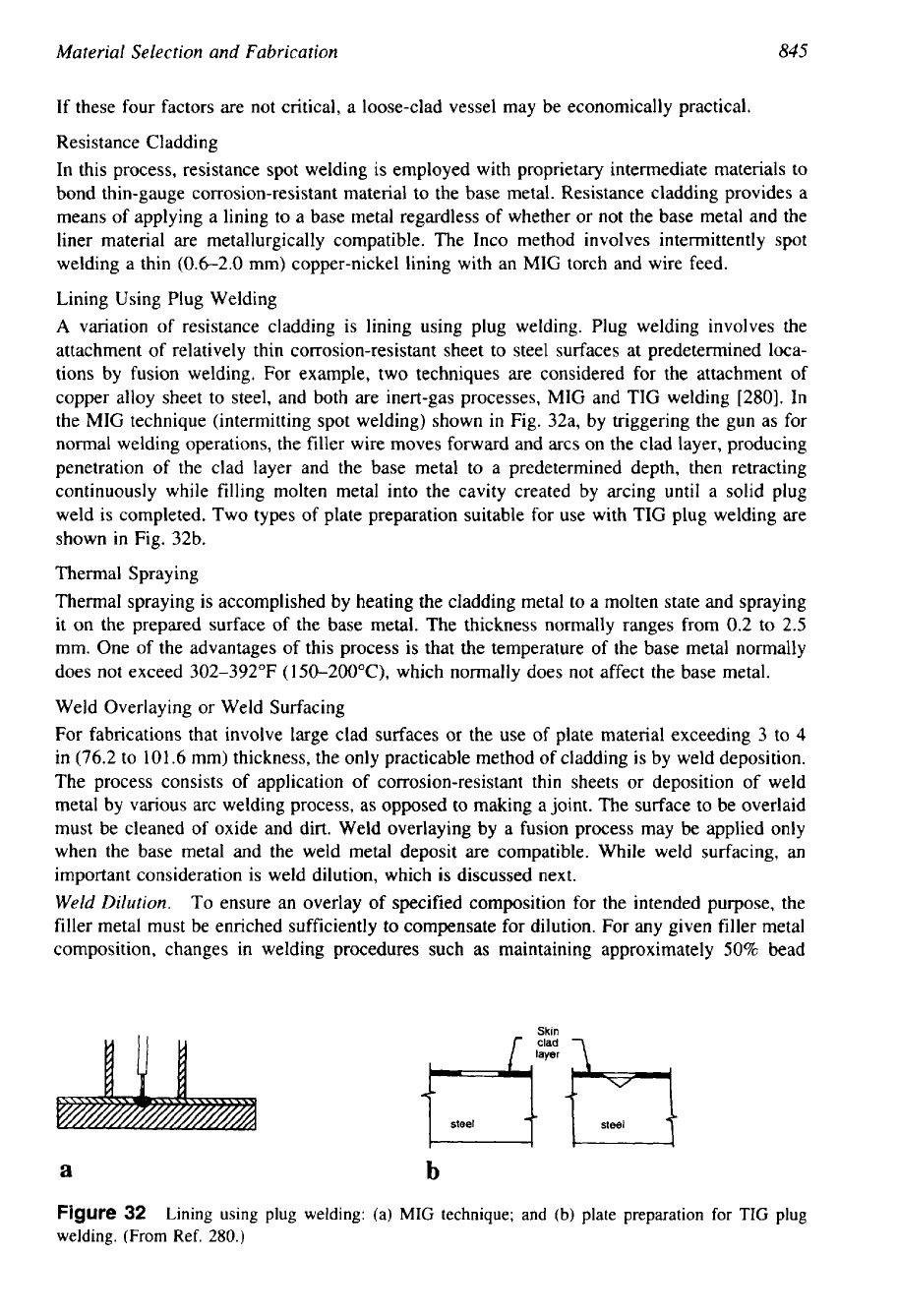
845
Material Selection and Fabrication
If these four factors are not critical, a loose-clad vessel may be economically practical.
Resistance Cladding
In this process, resistance spot welding is employed with proprietary intermediate materials to
bond thin-gauge corrosion-resistant material to the base metal. Resistance cladding provides a
means of applying a lining to a base metal regardless of whether or not the base metal and the
liner material are metallurgically compatible. The Inco method involves intermittently spot
welding a thin (0.6-2.0 mm) copper-nickel lining with an MIG torch and wire feed.
Lining Using Plug Welding
A
variation of resistance cladding is lining using plug welding. Plug welding involves the
attachment of relatively thin corrosion-resistant sheet to steel surfaces at predetermined loca-
tions by fusion welding. For example, two techniques are considered for the attachment of
copper alloy sheet to steel, and both are inert-gas processes, MIG and TIG welding [280]. In
the MIG technique (intermitting spot welding) shown in Fig. 32a, by triggering the gun as for
normal welding operations, the filler wire moves forward and arcs on the clad layer, producing
penetration of the clad layer and the base metal to a predetermined depth, then retracting
continuously while filling molten metal into the cavity created by arcing until a solid plug
weld is completed. Two types of plate preparation suitable for use with TIG plug welding are
shown in Fig. 32b.
Thermal Spraying
Thermal spraying is accomplished by heating the cladding metal to a molten state and spraying
it on the prepared surface of the base metal. The thickness normally ranges from
0.2
to 2.5
mm. One of the advantages of this process is that the temperature of the base metal normally
does not exceed 302-392°F
(
150-2OO0C), which normally does not affect the base metal.
Weld Overlaying or Weld Surfacing
For fabrications that involve large clad surfaces or the use of plate material exceeding
3
to
4
in
(76.2
to
101.6
mm) thickness, the only practicable method of cladding is by weld deposition.
The process consists
of
application of corrosion-resistant
thin
sheets or deposition of weld
metal by various arc welding process, as opposed to making a joint. The surface to be overlaid
must be cleaned of oxide and dirt. Weld overlaying by a fusion process may be applied only
when the base metal and the weld metal deposit are compatible. While weld surfacing, an
important consideration is weld dilution, which is discussed next.
Weld Dilution.
To ensure an overlay
of
specified composition for the intended purpose, the
filler metal must be enriched sufficiently to compensate for dilution. For any given filler metal
composition, changes in welding procedures
such
as
maintaining approximately
50%
bead
a
Figure
32
Lining using
plug welding: (a) MIG technique; and
(b)
plate preparation for TIG plug
welding.
(From
Ref.
280.)
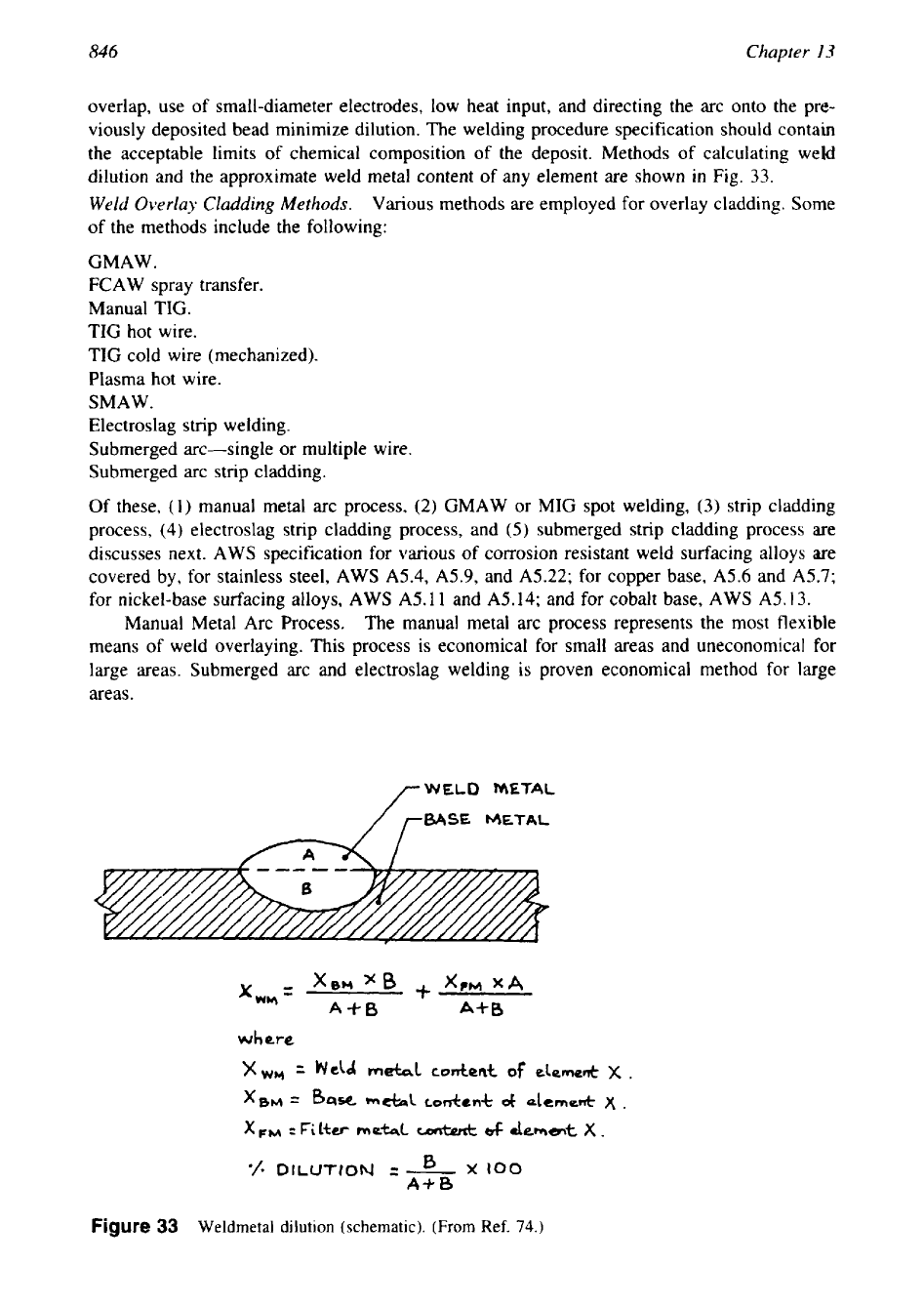
846
Chapter
I3
overlap, use of small-diameter electrodes, low heat input, and directing the arc onto the pre-
viously deposited bead minimize dilution. The welding procedure specification should contain
the acceptable limits of chemical composition of the deposit. Methods of calculating wekl
dilution and the approximate weld metal content of any element are shown in Fig.
33.
Weld
Overlay
Cladding Methods.
Various methods are employed for overlay cladding. Some
of the methods include the following:
GMAW.
FCAW spray transfer.
Manual TIG.
TIG hot wire.
TIG cold wire (mechanized).
Plasma hot wire.
SMAW.
Electroslag strip welding.
Submerged arc-single or multiple wire.
Submerged arc strip cladding.
Of
these,
(1)
manual metal arc process, (2) GMAW or MIG spot welding,
(3)
strip cladding
process,
(4)
electroslag strip cladding process, and
(5)
submerged strip cladding process are
discusses next. AWS specification for various of corrosion resistant weld surfacing alloys are
covered by, for stainless steel, AWS A5.4,
A5.9,
and A5.22; for copper base, A5.6 and
A5.7;
for nickel-base surfacing alloys, AWS A5.11 and A5.14; and for cobalt base, AWS
A5.13.
Manual Metal Arc Process.
The manual metal arc process represents the most flexible
means of weld overlaying. This process is economical for small areas and uneconomical for
large areas. Submerged arc and electroslag welding is proven economical method for large
areas.
WELO
METAL
BASE
METAL
'/.
OILUT~ON
2-
B
X
100
A+0
Figure
33
Weldmetal dilution (schematic). (From Ref.
74.)
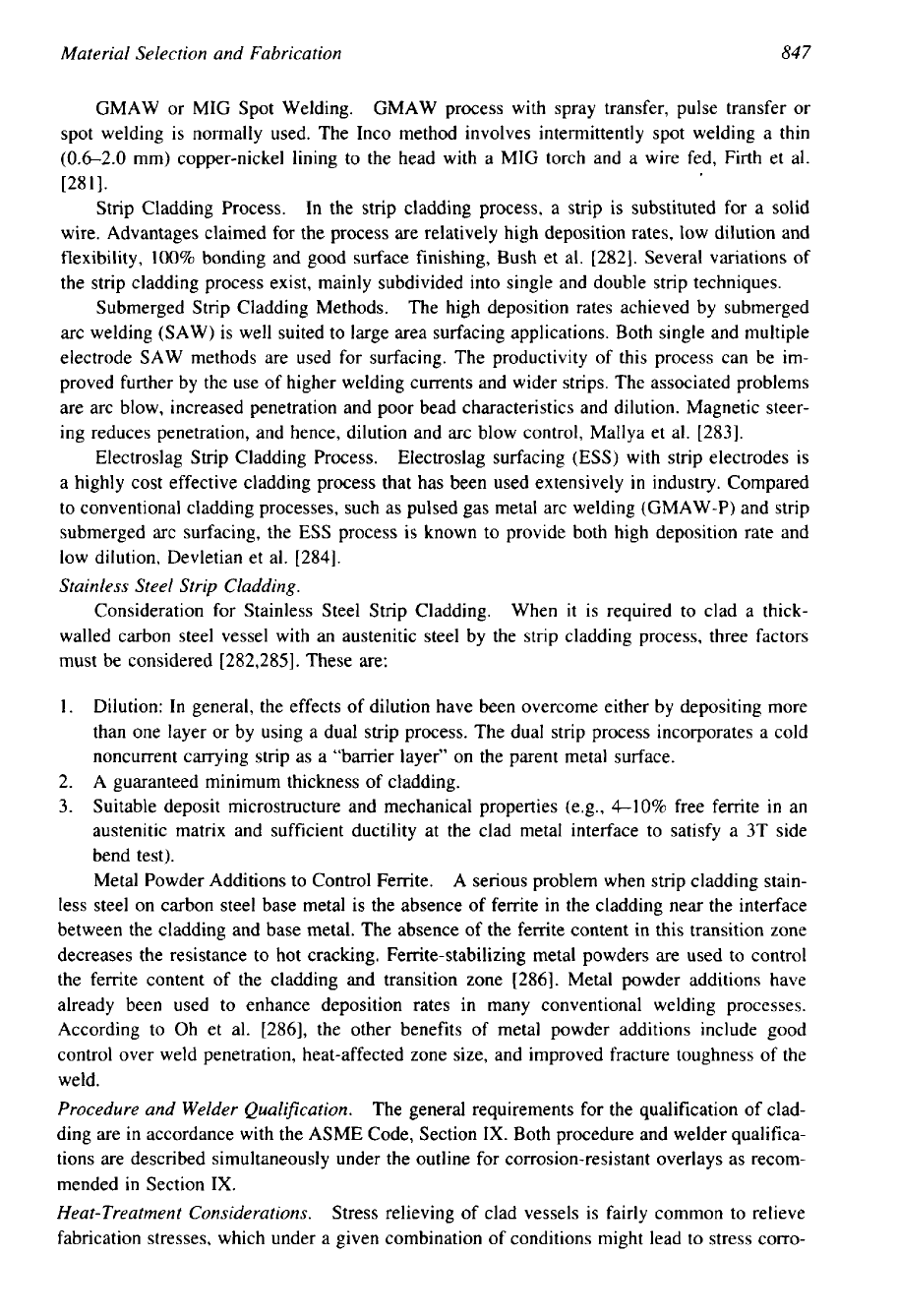
Material Selection and Fabrication
84
7
GMAW or MIG Spot Welding.
GMAW process with spray transfer, pulse transfer or
spot welding is normally used. The Inco method involves intermittently spot welding a thin
(0.6-2.0 mm) copper-nickel lining to the head with a MIG torch and a wire fed, Firth et al.
[281].
Strip Cladding Process.
In the strip cladding process, a strip is substituted for a solid
wire. Advantages claimed for the process are relatively high deposition rates, low dilution and
flexibility,
100%
bonding and good surface finishing, Bush et al. [282]. Several variations of
the strip cladding process exist, mainly subdivided into single and double strip techniques.
Submerged Strip Cladding Methods.
The high deposition rates achieved by submerged
arc welding (SAW) is well suited to large area surfacing applications. Both single and multiple
electrode SAW methods are used for surfacing. The productivity of this process can be im-
proved further by the use of higher welding currents and wider strips. The associated problems
are arc blow, increased penetration and poor bead characteristics and dilution. Magnetic steer-
ing reduces penetration, and hence, dilution and arc blow control, Mallya et al. [283].
Electroslag Strip Cladding Process.
Electroslag surfacing
(ESS)
with strip electrodes is
a highly cost effective cladding process that has been used extensively
in
industry. Compared
to conventional cladding processes, such as pulsed gas metal arc welding (GMAW-P) and strip
submerged arc surfacing, the
ESS
process is known to provide both high deposition rate and
low dilution, Devletian et al. [284].
Stainless Steel Strip Cladding.
Consideration for Stainless Steel Strip Cladding. When
it
is required to clad a thick-
walled carbon steel vessel with an austenitic steel by the strip cladding process, three factors
must be considered [282,285]. These are:
1.
Dilution: In general, the effects of dilution have been overcome either by depositing more
than one layer or by using a dual strip process. The dual strip process incorporates a cold
noncurrent carrying strip as a “barrier layer” on the parent metal surface.
2.
A guaranteed minimum thickness of cladding.
3.
Suitable deposit microstructure and mechanical properties (e.g.,
610%
free ferrite
in
an
austenitic matrix and sufficient ductility at the clad metal interface to satisfy a 3T side
bend test).
Metal Powder Additions to Control Ferrite. A serious problem when strip cladding stain-
less steel on carbon steel base metal is the absence of ferrite in the cladding near the interface
between the cladding and base metal. The absence of the ferrite content in this transition zone
decreases the resistance to hot cracking. Ferrite-stabilizing metal powders are used to control
the ferrite content of the cladding and transition zone [286]. Metal powder additions have
already been used to enhance deposition rates in many conventional welding processes.
According to Oh et al. [286], the other benefits of metal powder additions include good
control over weld penetration, heat-affected zone size, and improved fracture toughness of the
weld.
Procedure and Welder Qualification.
The general requirements for the qualification of clad-
ding are in accordance with the ASME Code, Section IX. Both procedure and welder qualifica-
tions are described simultaneously under the outline for corrosion-resistant overlays as recom-
mended in Section IX.
Heat-Treatment Considerations.
Stress relieving of clad vessels is fairly common to relieve
fabrication stresses, which under a given combination of conditions might lead to stress corro-
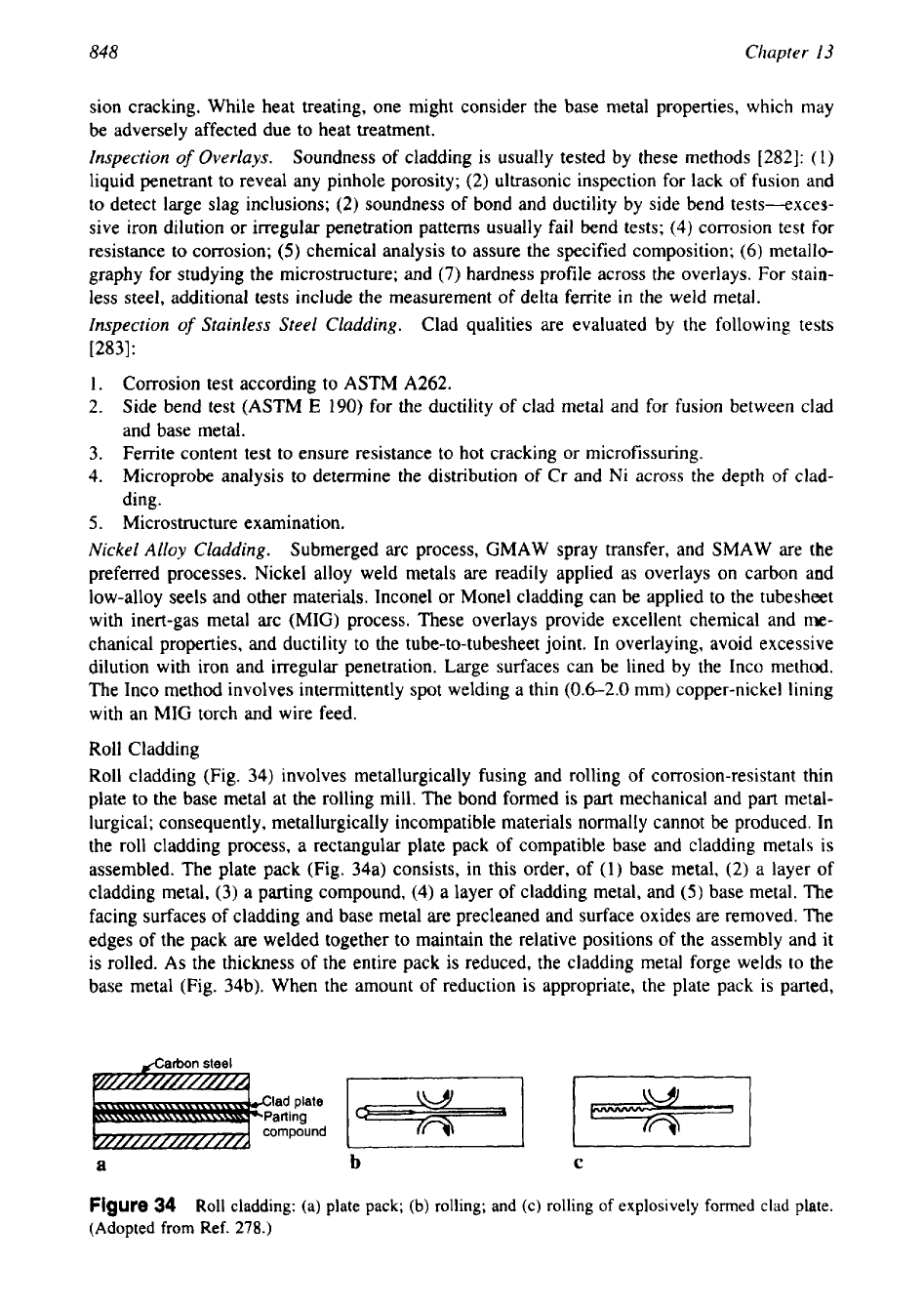
848
Chapter
I3
sion cracking. While heat treating, one might consider the base metal properties, which may
be adversely affected due to heat treatment.
Znspection
of
Overlays.
Soundness of cladding is usually tested by these methods
[282]:
(1)
liquid penetrant to reveal any pinhole porosity; (2) ultrasonic inspection for lack of fusion and
to detect large slag inclusions; (2) soundness of bond and ductility by side bend tests-exces-
sive iron dilution or irregular penetration patterns usually fail bend tests;
(4)
corrosion test for
resistance to corrosion;
(5)
chemical analysis to assure the specified composition;
(6)
metallo-
graphy for studying the microstructure; and
(7)
hardness profile across the overlays. For stain-
less steel, additional tests include the measurement of delta ferrite in the weld metal.
Inspection
of
Stainless Steel Cladding.
Clad qualities are evaluated by the following tests
[283]:
1.
Corrosion test according to ASTM A262.
2.
Side bend test (ASTM
E
190)
for the ductility of clad metal and for fusion between clad
and base metal.
3.
Ferrite content test to ensure resistance to hot cracking or microfissuring.
4.
Microprobe analysis to determine the distribution of Cr and Ni across the depth of clad-
ding.
5.
Microstructure examination.
Nickel
Alloy
Cladding.
Submerged arc process, GMAW spray transfer, and SMAW are the
preferred processes. Nickel alloy weld metals are readily applied as overlays on carbon and
low-alloy seels and other materials. Inconel or Monel cladding can be applied to the tubesheet
with inert-gas metal arc (MIG) process. These overlays provide excellent chemical and
me-
chanical properties, and ductility
to
the tube-to-tubesheet joint. In overlaying, avoid excessive
dilution with iron and irregular penetration. Large surfaces can be lined by the Inco method.
The Inco method involves intermittently spot welding a thin
(0.6-2.0
mm) copper-nickel lining
with an MIG torch and wire feed.
Roll Cladding
Roll cladding (Fig.
34)
involves metallurgically fusing and rolling of corrosion-resistant thin
plate to the base metal at the rolling mill. The bond formed is part mechanical and part metal-
lurgical; consequently, metallurgically incompatible materials normally cannot be produced. In
the roll cladding process, a rectangular plate pack of compatible base and cladding metals is
assembled. The plate pack (Fig. 34a) consists, in this order, of
(1)
base metal,
(2)
a layer of
cladding metal, (3) a parting compound, (4) a layer of cladding metal, and
(5)
base metal. The
facing surfaces of cladding and base metal are precleaned and surface oxides are removed. The
edges of the pack
are
welded
together to maintain the relative positions of the assembly and it
is rolled. As the thickness of
the entire pack is reduced, the cladding metal forge welds to
the
base metal (Fig. 34b). When
the amount of reduction is appropriate, the plate pack is parted,
&Carbon
steel
I
1
lad
plate
I
I
~
arting
l+l
I
I
a
b
C
Figure
34
Roll cladding: (a) plate pack;
(b)
rolling; and
(c)
rolling of explosively formed clad
plate.
(Adopted
from
Ref.
278.)
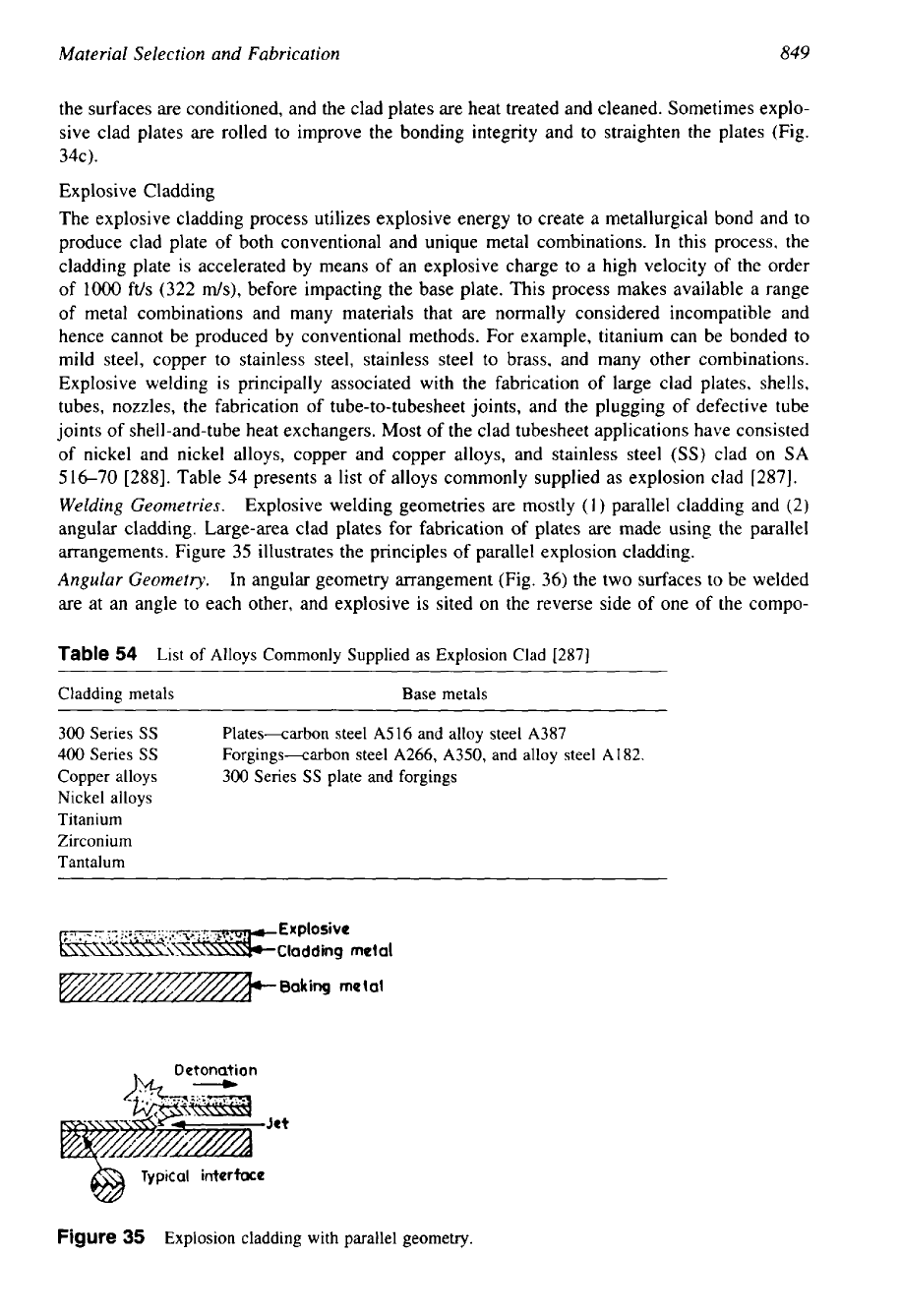
849
Material Selection and Fabrication
the surfaces are conditioned, and the clad plates are heat treated and cleaned. Sometimes explo-
sive clad plates are rolled to improve the bonding integrity and to straighten the plates (Fig.
34c).
Explosive Cladding
The explosive cladding process utilizes explosive energy to create a metallurgical bond and
to
produce clad plate
of
both conventional and unique metal combinations. In this process, the
cladding plate is accelerated by means of
an
explosive charge to a high velocity of the order
of
1000
ftjs (322
ds),
before impacting the base plate. This process makes available a range
of metal combinations and many materials that are normally considered incompatible and
hence cannot be produced by conventional methods. For example, titanium can be bonded to
mild steel, copper to stainless steel, stainless steel to brass, and many other combinations.
Explosive welding is principally associated with the fabrication of large clad plates, shells,
tubes, nozzles, the fabrication of tube-to-tubesheet joints, and the plugging of defective tube
joints of shell-and-tube heat exchangers. Most of the clad tubesheet applications have consisted
of nickel and nickel alloys, copper and copper alloys, and stainless steel
(SS)
clad on
SA
516-70
[288]. Table
54
presents a list of alloys commonly supplied as explosion clad [287].
Welding Geometries.
Explosive welding geometries are mostly
(1)
parallel cladding and
(2)
angular cladding. Large-area clad plates for fabrication
of
plates are made using the parallel
arrangements. Figure 35 illustrates the principles of parallel explosion cladding.
Angular Geometry.
In angular geometry arrangement (Fig. 36) the two surfaces to be welded
are at an angle to each other, and explosive is sited on the reverse side of one of the compo-
Table
54
List
of
Alloys Commonly Supplied as Explosion Clad
[287]
Cladding metals Base metals
300
Series
SS
Plates-carbon steel
A516
and alloy steel
A387
400
Series
SS
Forgings-carbon steel
A266, A350,
and alloy steel
A182.
Copper alloys
300
Series
SS
plate and forgings
Nickel alloys
Titanium
Zirconium
Tantalum
&~---&~c,
Explosive
\-
adding
mekd
0
et
on
at
i
o
n
b-
Typical
intertocc
Figure
35
Explosion cladding with parallel geometry.
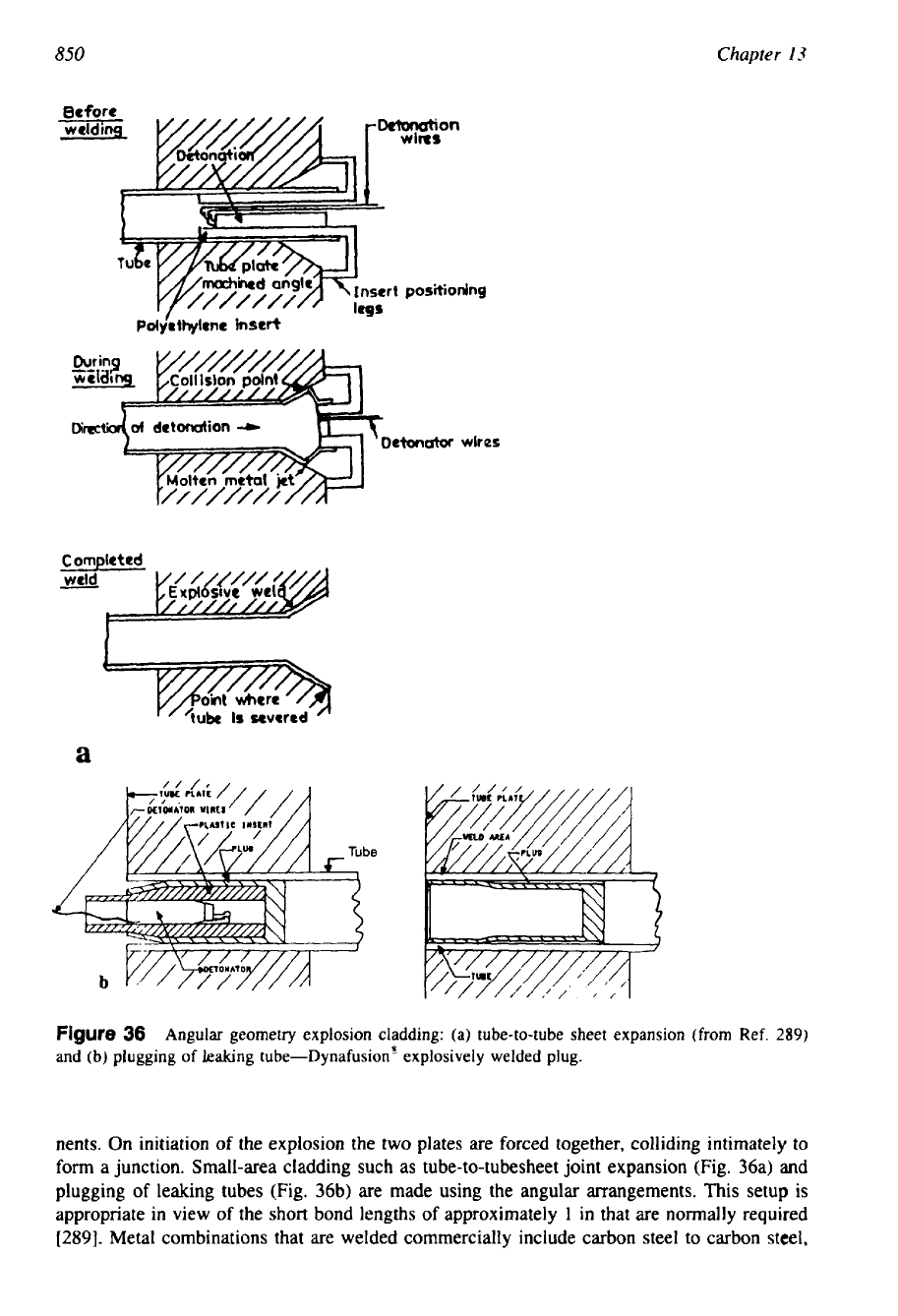
850
Chapter
13
Completed
weld
-
a
Figure
36
Angular geometry explosion cladding: (a) tube-to-tube sheet expansion (from Ref.
289)
and (b) plugging
of
kakmg tube-Dynafusion' explosively welded plug.
nents. On initiation
of
the explosion the two plates are forced together, colliding intimately to
form
a
junction. Small-area cladding such as tube-to-tubesheet joint expansion (Fig. 36a) and
plugging
of
leaking tubes (Fig. 36b) are made using the angular arrangements.
This
setup is
appropriate in view
of
the short bond lengths
of
approximately
1
in that are normally required
[289].
Metal combinations that are welded commercially include carbon steel to carbon steel,
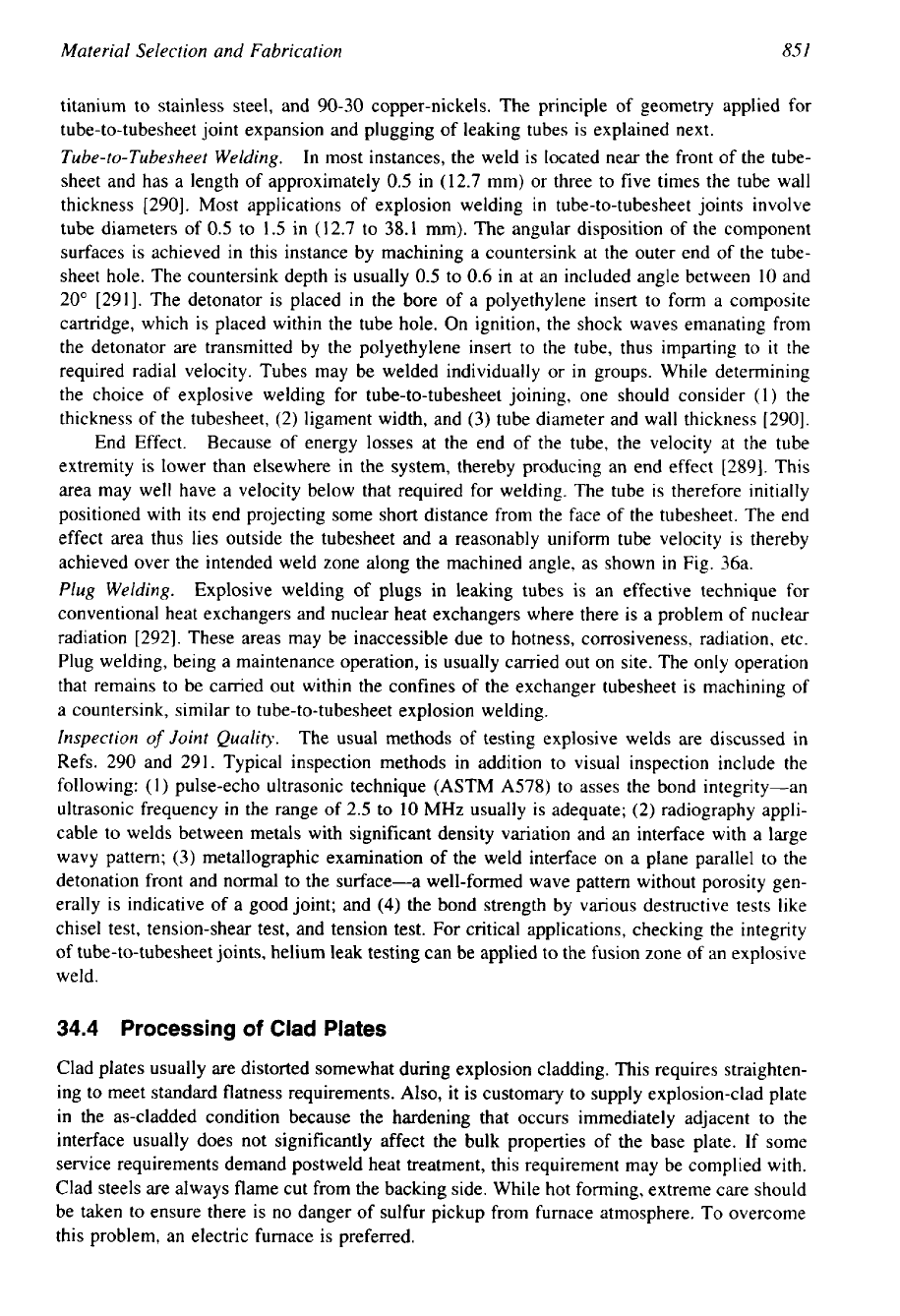
Material Selection and Fabrication
851
titanium to stainless steel, and 90-30 copper-nickels. The principle of geometry applied for
tube-to-tubesheet joint expansion and plugging of leaking tubes is explained next.
Tube-to-Tubesheet Welding.
In most instances, the weld is located near the front of the tube-
sheet and has a length of approximately
0.5
in (12.7 mm) or three to five times the tube wall
thickness [290]. Most applications of explosion welding in tube-to-tubesheet joints involve
tube diameters of
0.5
to 1.5 in (12.7 to 38.1
mm).
The angular disposition of the component
surfaces is achieved in this instance by machining a countersink at the outer end of the tube-
sheet hole. The countersink depth is usually
0.5
to 0.6 in at an included angle between
10
and
20" [291]. The detonator is placed
in
the bore of a polyethylene insert to form a composite
cartridge, which is placed within the tube hole. On ignition, the shock waves emanating from
the detonator are transmitted by the polyethylene insert to the tube, thus imparting to it the
required radial velocity. Tubes may be welded individually or
in
groups. While determining
the choice of explosive welding for tube-to-tubesheet joining, one should consider
(
1
)
the
thickness of the tubesheet, (2) ligament width, and
(3)
tube diameter and wall thickness [290].
End Effect.
Because of energy losses at the end of the tube, the velocity at the tube
extremity is lower than elsewhere in the system, thereby producing an end effect
[289].
This
area may well have a velocity below that required for welding. The tube is therefore initially
positioned with its end projecting some short distance from the face of the tubesheet. The end
effect area thus lies outside the tubesheet and a reasonably uniform tube velocity is thereby
achieved over the intended weld zone along the machined angle, as shown in Fig. 36a.
Plug Welding.
Explosive welding of plugs in leaking tubes is an effective technique for
conventional heat exchangers and nuclear heat exchangers where there
is
a problem of nuclear
radiation [292]. These areas may be inaccessible due to hotness, corrosiveness, radiation, etc.
Plug welding, being a maintenance operation, is usually carried out on site. The only operation
that remains to be carried out within the confines of the exchanger tubesheet is machining of
a countersink, similar to tube-to-tubesheet explosion welding.
Inspection
of
Joint Quality.
The usual methods of testing explosive welds are discussed in
Refs. 290 and 291. Typical inspection methods in addition to visual inspection include the
following: (1) pulse-echo ultrasonic technique (ASTM A578) to asses the bond integrity-an
ultrasonic frequency in the range
of
2.5
to
10
MHz
usually is adequate;
(2)
radiography appli-
cable to welds between metals with significant density variation and an interface with a large
wavy pattern;
(3)
metallographic examination of the weld interface on a plane parallel to the
detonation front and normal to the surface-a well-formed wave pattern without porosity gen-
erally is indicative of a good joint; and
(4)
the bond strength by various destructive tests like
chisel test, tension-shear test, and tension test. For critical applications, checking the integrity
of tube-to-tubesheet joints, helium leak testing can be applied to the fusion zone of an explosive
weld.
34.4
Processing
of
Clad
Plates
Clad plates usually are distorted somewhat during explosion cladding. This requires straighten-
ing to meet standard flatness requirements. Also, it is customary to supply explosion-clad plate
in the as-cladded condition because the hardening that occurs immediately adjacent to the
interface usually does not significantly affect the bulk properties of the base plate. If some
service requirements demand postweld heat treatment, this requirement may be complied with.
Clad steels are always flame cut from the backing side. While hot forming, extreme care should
be taken to ensure there is no danger of sulfur pickup from furnace atmosphere. To overcome
this problem, an electric furnace is preferred.
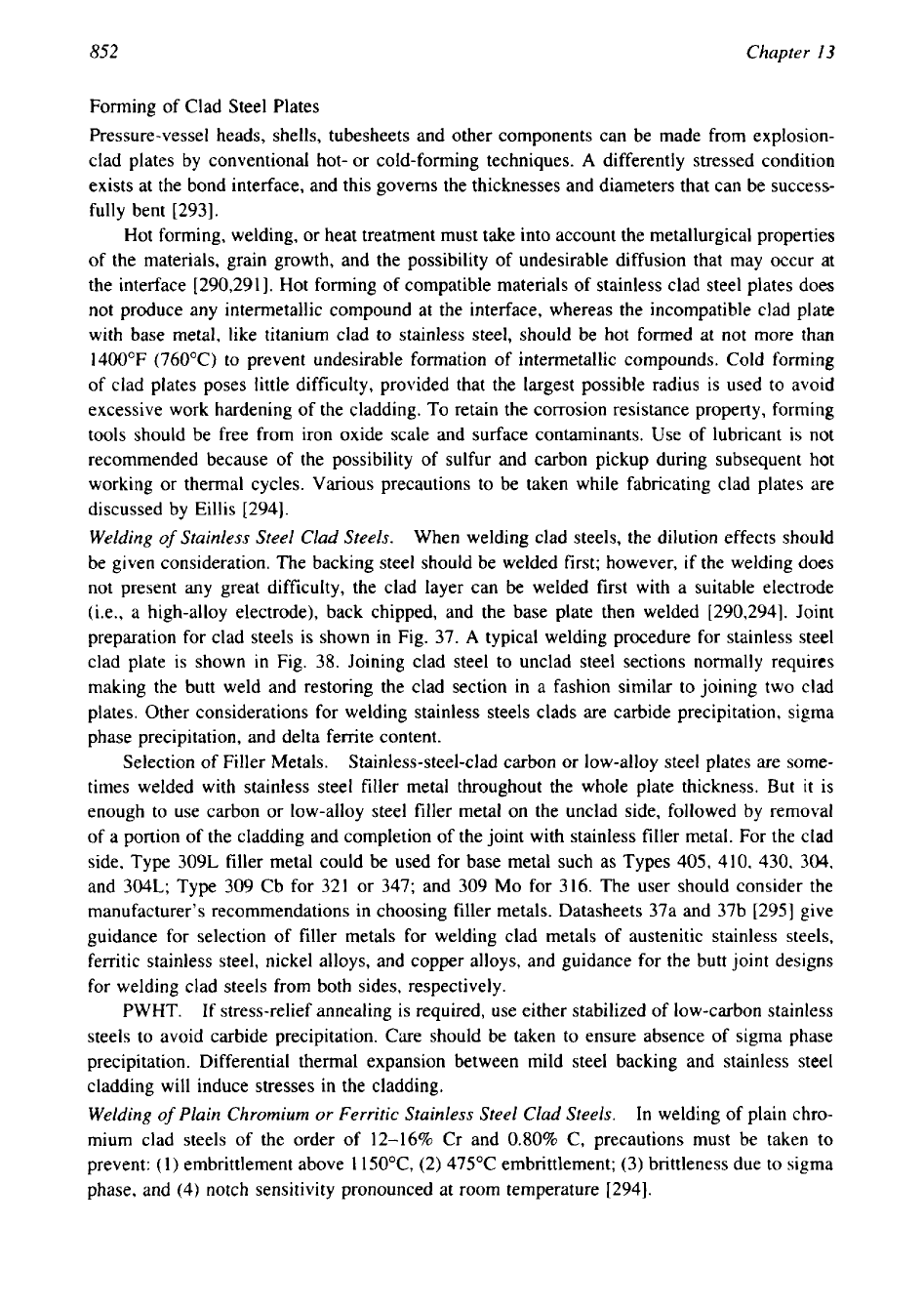
852
Chapter
I3
Forming of Clad Steel Plates
Pressure-vessel heads, shells, tubesheets and other components can be made from explosion-
clad plates by conventional hot- or cold-forming techniques.
A
differently stressed condition
exists at the bond interface, and this governs the thicknesses and diameters that can be success-
fully bent [293].
Hot forming, welding, or heat treatment must take into account the metallurgical properties
of the materials, grain growth, and the possibility of undesirable diffusion that may occur at
the interface [290,291]. Hot forming of compatible materials of stainless clad steel plates does
not produce any intermetallic compound at the interface, whereas the incompatible clad plate
with base metal, like titanium clad to stainless steel, should be hot formed at not more than
1400°F (760°C) to prevent undesirable formation of intermetallic compounds. Cold forming
of
clad plates poses little difficulty, provided that the largest possible radius is used to avoid
excessive work hardening of the cladding. To retain the corrosion resistance property, forming
tools should be free from iron oxide scale and surface contaminants. Use of lubricant is not
recommended because
of
the possibility of sulfur and carbon pickup during subsequent hot
working or thermal cycles. Various precautions to be taken while fabricating clad plates are
discussed by Eillis [294].
Welding
of
Stainless
Steel
Clad Steels.
When welding clad steels, the dilution effects should
be given consideration. The backing steel should be welded first; however, if the welding does
not present any great difficulty, the clad layer can be welded first with a suitable electrode
(i.e,, a high-alloy electrode), back chipped, and the base plate then welded [290,294]. Joint
preparation for clad steels is shown in Fig. 37.
A
typical welding procedure for stainless steel
clad plate is shown in Fig. 38. Joining clad steel to unclad steel sections normally requires
making the butt weld and restoring the clad section in a fashion similar to joining two clad
plates. Other considerations for welding stainless steels clads are carbide precipitation, sigma
phase precipitation, and delta ferrite content.
Selection of Filler Metals.
Stainless-steel-clad carbon or low-alloy steel plates are some-
times welded with stainless steel filler metal throughout the whole plate thickness. But
it
is
enough to use carbon or low-alloy steel filler metal on the unclad side, followed by removal
of a portion of the cladding and completion of the joint with stainless filler metal. For the clad
side, Type 309L filler metal could be used for base metal such as Types 405, 410, 430,
304,
and 304L; Type 309 Cb for 321 or 347; and 309
MO
for 316. The user should consider the
manufacturer’s recommendations in choosing filler metals. Datasheets 37a and 37b [295] give
guidance for selection of filler metals for welding clad metals of austenitic stainless steels,
ferritic stainless steel, nickel alloys, and copper alloys, and guidance for the butt joint designs
for welding clad steels from both sides, respectively.
PWHT.
If stress-relief annealing is required, use either stabilized of low-carbon stainless
steels to avoid carbide precipitation. Care should be taken to ensure absence of sigma phase
precipitation. Differential thermal expansion between mild steel backing and stainless steel
cladding will induce stresses in the cladding.
Welding
of
Plain Chromium
or
Ferritic Stainless Steel Clad Steels.
In
welding of plain chro-
mium clad steels of the order of 12-16% Cr and
0.80%
C, precautions must be taken to
prevent:
(1)
embrittlement above 1 15OoC, (2) 475°C embrittlement; (3) brittleness due to sigma
phase, and
(4)
notch sensitivity pronounced at room temperature [294].
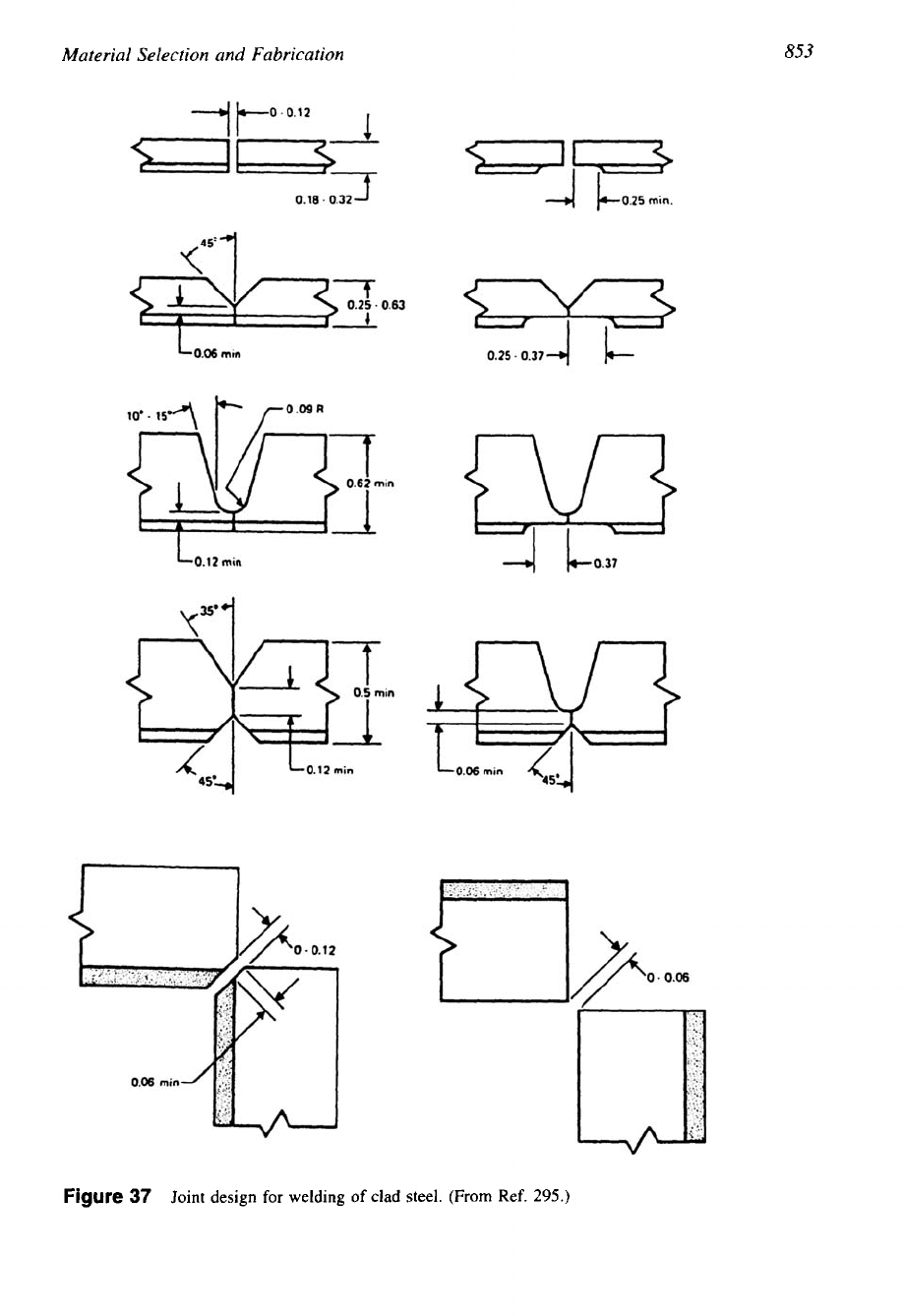
853
Material Selection and Fabrication
Figure
37
Joint
design
for
welding of clad steel.
(From
Ref.
295.)
